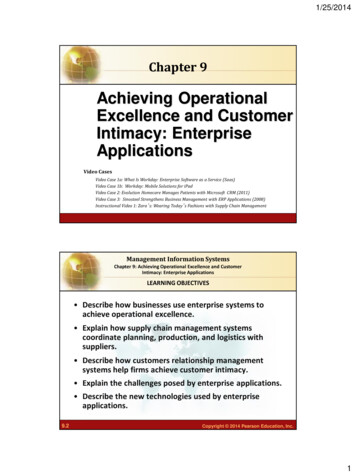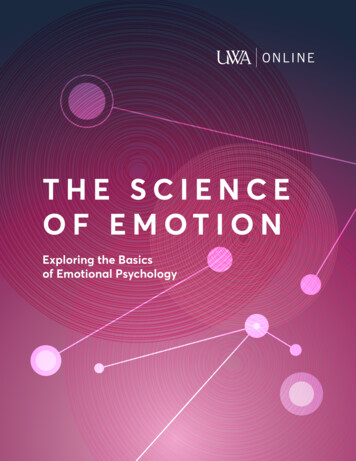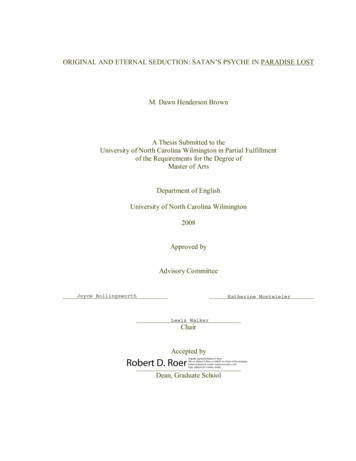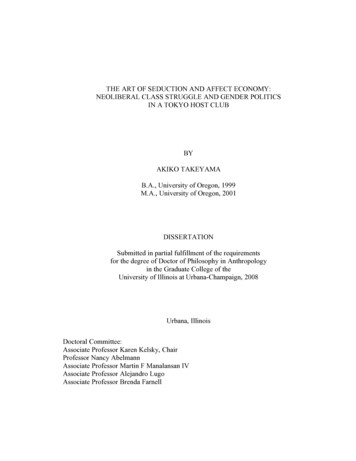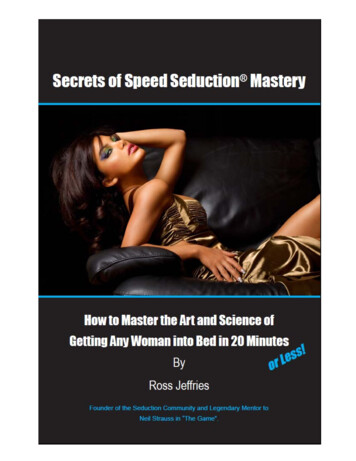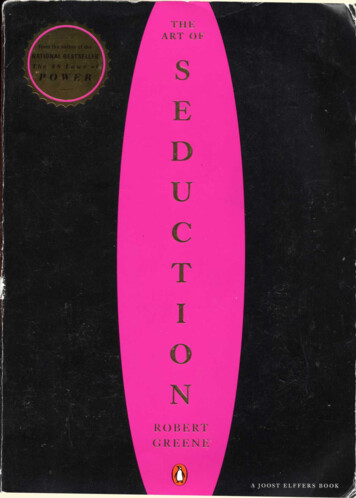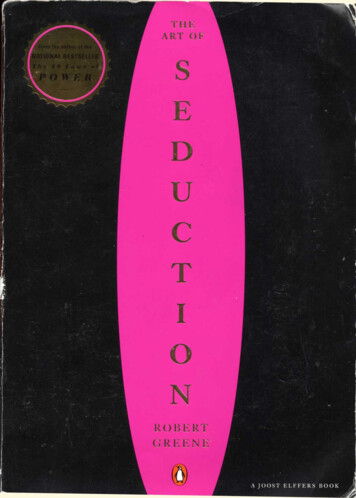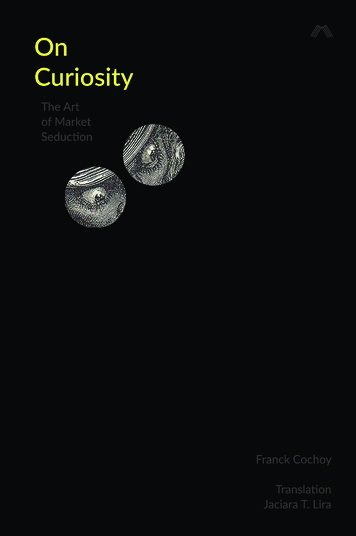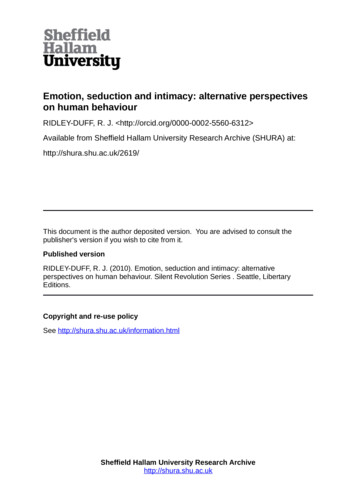
Transcription
Emotion, seduction and intimacy: alternative perspectiveson human behaviourRIDLEY-DUFF, R. J. http://orcid.org/0000-0002-5560-6312 Available from Sheffield Hallam University Research Archive (SHURA) at:http://shura.shu.ac.uk/2619/This document is the author deposited version. You are advised to consult thepublisher's version if you wish to cite from it.Published versionRIDLEY-DUFF, R. J. (2010). Emotion, seduction and intimacy: alternativeperspectives on human behaviour. Silent Revolution Series . Seattle, LibertaryEditions.Copyright and re-use policySee http://shura.shu.ac.uk/information.htmlSheffield Hallam University Research Archivehttp://shura.shu.ac.uk
Silent Revolution SeriesEmotionSeduction& IntimacyAlternative Perspectives onHuman BehaviourThird Edition Dr Rory Ridley-Duff, 2010Edited by Dr Poonam ThapaLibertary EditionsSeattle
Dr Rory Ridley‐Duff, 2010Rory Ridley‐Duff has asserted his right to be identified as the author of this work inaccordance with the Copyright, Designs and Patents Acts 1988.This work is licensed under a Creative Commons Attribution‐Noncommercial‐No Derivative Works 3.0Unported License.Attribution — You must attribute the work in the manner specified by the author or licensor (but not inany way that suggests that they endorse you or your use of the work).Noncommercial — You may not use this work for commercial purposes.No Derivative Works — You may not alter, transform, or build upon this work.Inquiries about additional permissions should be directed to: roryridleyduff@tiscali.co.ukSocial Exchange logo designed by Natasha Ridley‐DuffFirst edition commissioned by Social Exchange Ltd.Social Exchange Logo by Natasha Ridley‐Duff.First edition published by Men’s Hour Books, 2007.Second edition published by Rory Ridley‐Duff on www.scribd.com, 2009.Third edition published by Libertary, 2010.ISBN 978‐1‐935961‐00‐0DISCOUNTS OR CUSTOMIZED EDITIONS MAY BE AVAILABLE FOR EDUCATIONAL AND OTHER GROUPSBASED ON BULK PURCHASE.For further information please contact info@libertary.comLibrary of Congress Control Number: 2010939463
ContentsIntroduction. iAcknowledgements. iSetting Out the Terrain . iiiThe Structure of the Book . xiiiChapter 1 – In the Beginning . . 1Overview .1A Perspective on Sexism.4Setting the Agenda for Equality.10To the Reader.12Chapter 2 – What are Emotions?. 17Overview .17Emotional Knowledge.21Stories of Emotional Intelligence.26Emotional Defence and Emotion Management .30Emotion, Blame and Social Status.32Emotion and Perception.34Emotion and Sense-Making .36Emotional Sensitivity and Performance .38Summary .39Chapter 3 - Friendship and Flirting. 43Introduction .43
What is Seduction? .47Defining Seduction and Intimacy.54Seduction in Business .59Summarising the Seduction Process .62Redefining Intimacy.64Corporate Seduction .66Seduction in the Sales Process.79What Happens if the Seduction Fails? .82Summary .87Chapter 4 - Control and Discipline.94Overview.94Why Control and Discipline?.99Stories of Discipline and Control.103Feelings and Motives During Disciplining .115Learning from Conflict .119Social Influence During Conflict.122A Second Case.124The Dynamics of Discipline and Control .130Alternative Approaches to Managing Conflict .132Summary .141Chapter 5 – Leaders and Followers .145Introduction .145The Five Components of Power .154Bottom Up and Top Down Leaders .156Hazing and Harassment .163
A Second Case.170Reconsidering the Nature of Leadership .177Summary .179Chapter 6 – Sexual Conflict . 183Introduction .183A Story of Sexual Conflict .184Confronting the Double-Standard .204The Current State of the Gender Equality Debate.216Obstacles to Resolving Sexual Conflicts .219Are Men ‘Naturally’ Violent? .221The “Problem” of Courtship.226Summary .230Chapter 7 – Copies Strategies. 236An Introduction .236The Impacts of Intimacy at Work .238Tackling the Intimacy “Problem” .242The Centrality of Sexuality .250The Case for Change.255The Case for Mediation .258Reconstructing the Gender Debate .261Leaders, Performers and Followers.265Chapter 8 - Closing Thoughts . 272Conclusions .272
Appendix A – Body Language.274Introduction .274Speech Code .277Vocal Code .281Body Language Code.284Facial Code.289Bibliography, References and Recommended Reading.292For Those With a Casual or Professional Interest.292For Those With a Strong or Academic Interest .294
IntroductionAcknowledgementsAll books are collective enterprises with the author takingthe lead. This one is no different. My thanks must go toall the people who have touched my life in a way thatinforms this book, and particularly to those who haveread, fed back and argued about its contents with me. Iwant to take this opportunity to thank you all. Specialthanks are due to a number of people.Firstly, my wife Caroline, who has ridden with methrough the ups and downs of life. Her contribution tothis book goes far deeper than the words on the page. Shehas her own stories to tell and hearing them over theyears has been integral to my understanding of howrelationships in the workplace reach into all parts of ourlives.To Poonam, my muse in business, I owe both apersonal and professional debt. On a personal level, shehas shown unstinting faith that I am “an honest sort” withsomething worthwhile to say. On a professional level, shehas given tremendous support to the perspectivesarticulated in my earlier work and this book takes us bothcloser to making dreams come true.Professors John Cullen and Phil Johnson deserve amention for their guidance and insights into the materialpresented here, particularly with regard to social controland workplace culture. Minna Leinonen pointed me tothe work of Jeff Hearn and Wendy Parkin, and followedthis by building my confidence by writing with me ongender issues. Her contribution created more balance inmy thinking. Stephen Robinson deserves credit forreading and raising issues in the early drafts of Chapters1-5, while Jane and Andrew Cook’s thoughtfulcontribution to the discussion on defining seduction morepositively (Chapter 3) deserves appreciation.Myi
Emotion, Seduction & Intimacychildren, Natasha and Bethany, allowed me to sharestories about our family life in ways that show how deeplyour feelings underpin attempts to control or hurt others.My thanks to Raymond Cuttill for accepting thechallenge of first publishing this book. Following theprint of 100 copies, an eBook version at Scribd triggeredthousands of downloads indicating clear interest in thesubject matter of the book. Publishing a text thatquestions prevailing wisdom on gender issues is afrustrating and occupationally dangerous activity, but inthe last five years there has been a discernable change inthe media and academia and the evolution of a moreopen-minded attitude.My life has been a rich and varied one – there are somany people that I cannot name them all. There are a fewfriends, however, who I would like to acknowledge fordeveloping my thinking on the matters in this book. Mylove to: Helen Peters, Richard Churches, Angela Howes,Clare Byrne, Iain and Marianne Carnegie, Sabine Maier,Steve Anscombe, Phil Cole, Karen Smith, Lawrence Clare,Lyndsey Maw, Suzy Brookes and Mike Haywood. For thelast few years, I am indebted to professional colleagues atSheffield Business School, particularly Liz Doherty andTony Bennett who have provided feedback and support.ii
IntroductionSetting Out the TerrainThis book is a natural evolution for me after finishing astudy on which I worked full-time for three years. It waswritten to take a break from academic writing but as itdeveloped I found more secrets of life revealingthemselves to me and I quickly got hooked. My emotionswere fired as everything else stopped to finish the text.The content of the book is purposely aimed at workingpeople, particularly managers and professionals, whowant to understand how seduction and sexuality arecontinually used to develop the relationships upon whichbusiness (and families) depend. It may find favour with asecondary group studying or teaching business,psychology, philosophy, gender studies, governance,sociology, human rights, politics and law.Life is an endless process of probing and searching forsatisfying relationships for the purpose of economic andsocial gain. We constantly try to seduce each other fordifferent reasons. Beyond seduction to satisfy our sexualdesires, there are employers seducing employees (andvice versa), salespeople seducing customers, consultantsseducing clients, advertisers seducing consumers, writersseducing readers, musicians seducing listeners, andacademics, scientists, religious leaders and politicianspresenting seductive versions of “the truth”.The book contains stories of seduction in the publicworkplace and the impacts on our private emotions. Inmarriage, families and committed partnerships, wedisplay our emotions more freely than at work. Learningto cope with them often leads to the most durable andmeaningful relationships in our lives. Yet, at work, an“inappropriate” display of emotion can land a person indeep trouble, even result in their sacking or triggerwidespread upheaval in the office. It made me questionwhether our attitude to emotions is actually helpingbusiness or hurting it.I have adopted techniques common in social science tominimise authorial bias. One method is to focus oniii
Emotion, Seduction & Intimacyconversations taking place around us, rather than relyingon one-off interviews. Nevertheless, I have my ownbiases. I write about issues that interest and concern mefirst and foremost. One purpose of this introduction,therefore, is to set out my concerns to you so that you thereader can assess the extent to which this impacts onwhat I say in the book.My own interest is the way emotion and intimacydrives the way we govern each other and to organiseourselves into social groups. By looking at conversations,it is possible to discover that productive relationships,generally, are far more equitable than we realise. Onlywhen one party wants to punish the other dorelationships change dramatically. When hostility istriggered, one party cuts off or alters the way theycommunicate. Sometimes they start shaping situations sothey can hurt those who they think have hurt them.When this happens, we discover how power is organised,because one party is usually able to punish “the other”more completely and effectively than the other wayaround.The desire to punish is rooted in emotional hurt so akey objective of this book is to show where emotional hurtcomes from, and the ways that people punish each otherwhen it occurs. The results, I have no doubt, will shockyou and perhaps even rock your world a bit – at least Ihope it does. As a consequence, a new debate will developabout techniques to investigate “misbehaviour”,something I consider carefully in the final chapter.Winning and LosingIn our closest relationships we learn many things: how tolet others win as a way of developing their confidence;how to win sometimes so that others learn to deal withthe emotions aroused by losing. Learning to establish abalance between winning and losing, and teaching othershow to cope with winning and losing, is an experiencethat is quite different from the “win, win, win” mentalitythat now pervades workplaces.Winning is over-rated. Management researchers havelong noted the cycle of rapid business success followed byiv
soverconfidence and arrogance. Moreover, when winningbecomes more important than supporting thedevelopment of human life, we start to undermine thevery people who contribute to our own survival.Sometimes we mindlessly hurt without pause to considerthe long-term consequences, then compound theproblems by getting angry when others react to our owninsensitivity. Forgiveness is a quality much needed, butrarely found, in management thinking, despite thecompetitive advantage to be gained through its adoption.Failure is not a blot on our character, because in theprocess we learn to reflect and develop new ways ofthinking. In personal and social environments, failure isthe catalyst for profound learning out of which developsself-awareness, tolerance and competitive advantage.When those who fail in the workplace are sacked ratherthan supported, we marginalize the very people who arein the midst of learning the most and who potentiallyhave the most to contribute to the future.It is thisrealisation that has fuelled an interest in the link between‘no blame’ management cultures and commercialsuccess1.The Story So Far Interest in emotion was fuelled by the runaway success ofDaniel Goleman’s book Emotional Intelligence.2 As is thecase with many popular psychology books, Golemantends to view emotion as a product of genetic inheritanceand upbringing. Branches of academia, such as cognitiveand evolutionary psychology, also accept thispresumption to understand ‘personality’.In the social sciences (including business studies) theseminal works on emotion take a different view. InStephen Fineman’s writings, for example, emotion is seenas a outcome of group life, something that is triggered bychanges in our social status and relationships.3 Thistheme has been picked up by some psychiatrists, such asWilliam Glasser in Choice Theory.4When people are asked to talk about emotions at work,they do not – unless prompted by researchers orv
Emotion, Seduction & Intimacymanagers – talk about “job satisfaction” or a desire for“self-fulfilment”.Instead they talk about theirrelationships with work colleagues, family and friends.What matters in assessing a person’s emotionalbehaviour, therefore, is the situation in the here and now,not what happened 10 or 20 years ago. The past mayinfluence the way a person understands and deals withthe present, but the problem to be solved – the feelingsthat are being experienced – are in the present situation,not the past.Arlene Hochschild has documented another feature ofemotional life at work - the way we are encouraged toadopt emotions when we interact with work colleagues,managers, clients, customers and suppliers.5Herconcepts link back to Daniel Goleman but have a differentslant.What Goleman calls ‘emotional intelligence’Hochschild regards as ‘emotional labour’.UnlikeGoleman, who argues that emotional intelligence isbeneficial to us as human beings, Hochschild brings outanother aspect: constantly pretending or withholdingemotions undermines our sense of self, affects ourphysical health and undermines our capacity to actmorally.In my own research,6 I show how emotional skills –however we label them - take individuals into the heart ofcomplex social networks. Whether in business or politics,in love triangles or large families, we are drawn to thosewho trigger positive emotions in us, and we considerthem more desirable and trustworthy. People findthemselves, whether by their own design, or themanoeuvrings of others, embedded in complex andintimate relationships. The way people handle this is animportant dimension of leadership but it is rarelydiscussed as a management topic.My own contribution, therefore, was to demonstratescientifically how company governance practices, and thedevelopment of social structures at work, are partlyrooted in the way we handle intimacy and emotionality.Courtship rituals, and our interests as parents, influencethe development of workplace hierarchies. They have animpact that compares to market-forces, legal regulationsand company rules.vi
IntroductionAnother couple who confront the issue of intimacy areAndrew and Nada Kakabadse.7 They found that intimacyat work is a common experience, and the benefits areastonishingly enduring, often lasting a life-time. After myown study into workplace culture, I returned to theirwork and the stories had an even more profound effect onme. The insights that developed in second reading takeform and expression in these pages. In their conclusions,the Kakabadses talk of a need for people at work,particularly managers, to develop greater sensitivity sothey can handle intimacy and emotionality moreeffectively. This recommendation was underpinned by asurvey finding that only 11% of people at work thinkrelationship issues are handled well, and that only 2%believe that policy-based approaches to sexual conflictmake a positive contribution.The recent legislative attempts to bring aboutimprovements in behaviour by making employersresponsible for equality are – in the eyes of some –making matters much worse. Does it make sense to makemanagers legally responsible for preventing theaccidental upset of people at work? A person whoaccidentally upsets another can now be sacked if it can beshown that the effect of their behaviour was intimidating(even if unintended). Managers can be found guilty offailing to prevent a hostile environment if they do notremove a person who accidentally causes anotherdistress.As I show in this book, a person’s motive may be toshow care for another person or to debate discriminationissues affecting their own workplace, or just astraightforward positive response to the other’s obviousinterest. The result of legislative change is that we aredeveloping a culture that frustrates the pursuit of equalityby outlawing the emotionality of intimacy and debate. Ineffect, we are knowingly or unknowingly makingdemocracy illegal.At the same time, our world is increasingly driven byintolerance. In politics, we see world leaders orderingtroops into Iraq justified, not on the basis of credibleevidence of a threat to our nation, but to assuage the fearsand suspicions of our leaders. Riots erupt the world overvii
Emotion, Seduction & Intimacyafter publication of a blasphemous cartoon just as‘democracy’ is established in Iraq. In our own society,members of religious minorities fear prosecution forincitement to terrorism for publicly debating how torespond to their own government bombing members oftheir family in other countries (even when a majority ofall citizens opposed the war). We see Labour Partystewards ejecting an old-age pensioner for holding apolitical leader to account at a ‘democratic’ conferenceand then using anti-terror laws to prevent his furtherparticipation. At work, the result of ‘tightening up’ sexualdiscrimination legislation is that people can be demotedor sacked for trying to debate issues of sex discrimination,including something as trivial as choosing not to wear atie.This book, therefore, is a timely contribution thatargues why and how we will benefit by listening to ourown and others’ emotions as well as their words. This is atime to develop our capacity for tolerance and sensitivity.Secondly, I will argue that during conflict, the priority isto understand the source of emotion - both in ourselvesand others – rather than stamp it out throughauthoritarian behaviour, discipline, punishment andexclusion. To this end, I provide a wealth of stories thatwill help to understand the interconnections betweendifferent areas of our lives.The Science of EmotionEmotions – our own and others’ – have had a raw deal inthe credibility stakes, in both personal and professionalworlds, for around 200 years. In this book, I discuss howscience itself is beginning to establish how emotionsunderpin our intelligence. We have an innate ability to besensitive, and this sensitivity allows us to discovers waysof thinking that help us to survive. While the currentwave of intolerance is rooted in a global fear about ourcollective survival, the fear is rational even if the reactionsto it are not.As a social scientist, I do not believe anyone can becompletely objective. Even maths – often cited as thepurest of sciences – is a symbolic language. It is anviii
Introductioninvention by human beings to represent the world asmathematicians see it. The bias lies not in its inability toprecisely depict what is observed (it does this rather well)but in the purposes behind particular observations andthe way we report them.Maths, in principle, is no different from other ways ofrepresenting the world. I explore human existence usingother symbols - words and diagrams. These preciselydepict what I observe - just like the symbols of themathematician. While they might be more subtle andambiguous than mathematical formulae, they are no lessscientific. The insights and understandings that wordsand diagrams have generated over the centuries comparesfavourably to the mathematical formulae of someeconomists.Bringing together different worlds – in this casereconciling neuroscience with anthropology - creates amarriage between the natural and social sciences. As aresult, scientific insights are more profound. It meansthat a better informed debate can thrive and each of uscan apply what we learn in the here and now to improveour lives.My Personal Concerns and InterestsThere was a period of intense sadness in the middle ofwriting this book. You will read about this in Chapter 6.The sadness came from realising that 25 years ofcommitment to equality counted for nothing when Ifound myself in the middle of a dispute. In my teens I feltsympathy for, and actively supported, the women’smovement for emancipation. My contribution in adultlife was a commitment to listen to women, engage withthem in conversation over gender issues, work with themas equals, support their technical and emotionaldevelopment when able (and they were willing), promotethem when they were the best candidate for the job. Itrusted they would do all these things for me. At times Istood up and challenged sexist and racist attitudes thatlimited others’ potential.I know that by doing so, I did some good. The sadnesscame when I tried to do the same for men, and moreix
Emotion, Seduction & Intimacyrecently myself. This process started privately about 10years ago, but in the workplace and publicly I did not feelsufficiently confident until eight years later. By that time,double-standards towards men’s and women’s behaviourhad become so extreme that they screamed out to bechallenged, documented and brought into the publicdomain. But I was afraid to speak up. I am, therefore,grateful to those people, often women, who helped methrough that fear. Speaking up has not been easy andsometimes made me unpopular.The double-standards regarding men’s and women’ssexuality finds expression in the workplace. I learnt tomy personal cost that responding to women’s flirtybehaviour by engaging in light-hearted banter canthreaten both my career and family. One female managerwas apparently so upset at my joke about her gendersensitivity, that her employer - a client with whom I hadan unproblematic relationship for half my working life no longer felt it could retain my consultancy services.The following week, I watched Trinny and Susannahtell a businesswoman on prime time TV “what a great pairof tits you’ve got, get them out more” to help her promoteher business. Women enjoy media support to use theirsexuality in the workplace while men’s light-heartedsexual jokes (even when intended to raise genderinequality issues) can put their careers and marriages atrisk.It prompted me to return to studies I had found onfalse claims. I remembered an extensive investigation,with a rigorous methodology, that investigated over 500allegations.8 Three researchers found that 60% of sexualallegations turned out to be false. The three researcherswere so sceptical of the findings that they did two followup studies. The 60% figure held. It also holds in theKakabadse’s study on the issue of false claims aboutsexual harassment. To my surprise, the figure alsoemerged in a study of over 2,000 women in 10 cities in acompletely different cultural context. They were asked ifthey would tell anyone if they were sexually attracted to aman at work.9 Over half (61%) would not discuss thiswith anyone - not even their best friend.x
IntroductionThis means that there is a hidden side to sexualharassment that is important to both women and men,but for different reasons. As many men have their livesdisrupted or destroyed by false claims as women by actualharassment. In unravelling this, I also found that thereason for the high percentage of false allegations iswomen’s need to hide their (potential) infidelities fromother men. As those studying courtship have found, 93%of men and 82% of women in long-term relationshipsclaim others have attempted to seduce them into a newlong-term relationship.10 Other studies show that themajority of sexual relationships are initiated by womenrather than men (the most reliable research puts this atjust under 70%).11The disparities in men’s and women’s claims arethemselves interesting. Logically for every man whostarts a new sexual relationship with a women, there is awomen who starts one with a man. Logically, there mustbe equal numbers of women and men in committedrelationships and marriages. Why, then are the claims ofmen and women different? This tells its own story.It turns out that it is exceptional, rather than normal,to be committed to life-long fidelity. Men and women,however, differ in their desire for affairs and newrelationships. In a cross-cultural study of 37 countries i
Emotion, Seduction & Intimacy ii children, Natasha and Bethany, allowed me to share s
